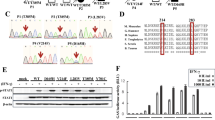Abstract
Studies in adult inflammatory bowel disease (IBD) patients have highlighted associations with genetic and serologic markers and suggest an association with disease location, behaviour and natural history. Data on patients with Crohn’s disease (CD, n = 80), ulcerative colitis (UC, n = 15) and indeterminate colitis (n = 4) were collected. All individuals were analysed for CARD15 R702W, G908R and L1007fs for toll-like receptor 4 (TLR4) Asp299Gly and for anti-Saccharomyces cerevisiae antibodies (ASCA) and atypical perinuclear antineutrophil cytoplasmatic antibodies (pANCA). After a mean of 10.7 years of follow up, the disease behaviour changed in 45% of CD patients, in contrast to disease location, where only 12.5% had a change (p < 0.001). The younger the age at diagnosis, the more patients presented with colonic disease (p = 0.021). Also, more TLR4 Asp299 Gly variants were found when the age at onset was younger (p = 0.018). A large number of concomitant diseases were observed. There was no difference in the prevalence of TLR4 variants nor ASCA or pANCA between the patients with or without concomitant diseases. Patients who progressed more often needed surgery as compared to patients who remained free of stenosing or fistulising disease (27/32 or 84% versus 3/35 or 8.6%, respectively, p < 0.0001) and more often had concomitant immune-mediated diseases and a trend for more seroreactivity towards ASCA.






Similar content being viewed by others
Abbreviations
- IBD:
-
Inflammatory bowel disease
- CD:
-
Crohn’s disease
- UC:
-
Ulcerative colitis
- TLR4:
-
Toll-like receptor 4
- CARD:
-
Caspase recruitment and oligomerisation domain
- ASCA:
-
Anti-Saccharomyces cerevisiae antibodies
- pANCA:
-
Atypical perinuclear antineutrophil cytoplasmatic antibodies
References
Abreu MT (2002) The pathogenesis of inflammatory bowel disease: translational implications for clinicians. Curr Gastroenterol Rep 4:481–489. doi:10.1007/s11894-002-0024-0
Ahmad T, Armuzzi A, Bunce M, Mulcahy-Hawes K, Marshall SE, Orchard TR et al (2002) The molecular classification of the clinical manifestations of Crohn’s disease. Gastroenterology 122:854–866. doi:10.1053/gast.2002.32413
Andruilli A, Annese V, Latiano A, Palmieri O, Fortina P, Ardizzone S et al (2004) The frame-shift mutation of the NOD2/CARD15 gene is significantly increased in ulcerative colitis: an *IG-IBD study. Gastroenterology 126:625–627. doi:10.1053/j.gastro.2003.12.027
Annese V, Lombardi G, Perri F, D’Incà R, Ardizzone S, Riegler G et al (2005) Variants of CARD15 are associated with an aggressive clinical course of Crohn’s disease—an IG-IBD study. Am J Gastroenterol 100:84–92. doi:10.1111/j.1572-0241.2005.40705.x
Bach JF (2002) Current concepts of autoimmunity. Rev Neurol (Paris) 158:881–886
Becker KG, Simon RM, Bailey-Wilson JE, Freidlin B, Biddison WE, McFarland HF et al (1998) Clustering of non-major histocompatibility complex susceptibility candidate loci in human autoimmune diseases. Proc Natl Acad Sci USA 95:9979–9984. doi:10.1073/pnas.95.17.9979
Beutler B (2004) Innate immunity: an overview. Mol Immunol 40:845–859. doi:10.1016/j.molimm.2003.10.005
Bousvaros A, Antonioli DA, Colletti RB, Dubinsky MC, Glickman JN, Gold BD et al (2007) Differentiating ulcerative colitis from Crohn disease in children and young adults: report of a working group of the North American Society for Pediatric Gastroenterology, Hepatology, and Nutrition and the Crohn’s and Colitis Foundation of America. J Pediatr Gastroenterol Nutr 44(5):653–674
Braat H, Stokkers P, Hommes T, Cohn D, Vogels E, Pronk I et al (2005) Consequence of functional Nod2 and Tlr4 mutations on gene transcription in Crohn’s disease patients. J Mol Med 83:601–609. doi:10.1007/s00109-005-0685-x
Cario E, Podolsky DK (2000) Differential alteration in intestinal epithelial cell expression of toll-like receptor 3 (TLR3) and TLR4 in inflammatory bowel disease. Infect Immun 68:7010–7017. doi:10.1128/IAI.68.12.7010-7017.2000
Cosnes J, Cattan S, Blain A, Beaugerie L, Carbonnel F, Parc R et al (2002) Long-term evolution of disease behavior of Crohn’s disease. Inflamm Bowel Dis 8:244–250. doi:10.1097/00054725-200207000-00002
Cuthbert AP, Fisher SA, Mirza MM, King K, Hampe J, Croucher PJ et al (2002) The contribution of NOD2 gene mutations to the risk and site of disease in inflammatory bowel disease. Gastroenterology 122:867–874. doi:10.1053/gast.2002.32415
Devlin SM, Yang H, Ippoliti A, Taylor KD, Landers CJ, Su X et al (2007) NOD2 variants and antibody response to microbial antigens in Crohn’s disease patients and their unaffected relatives. Gastroenterology 132:576–586. doi:10.1053/j.gastro.2006.11.013
Dubinsky MC, Lin YC, Dutridge D, Picornell Y, Landers CJ, Farrior S et al (2006) Serum immune responses predict rapid disease progression among children with Crohn’s disease: immune responses predict disease progression. Am J Gastroenterol 101:360–367. doi:10.1111/j.1572-0241.2006.00456.x
Franchimont D, Vermeire S, El Housni H, Pierik M, Van Steen K, Gustot T et al (2004) Deficient host-bacteria interactions in inflammatory bowel disease? The toll-like receptor (TLR)-4 Asp299gly polymorphism is associated with Crohn’s disease and ulcerative colitis. Gut 53:987–992. doi:10.1136/gut.2003.030205
Girardin SE, Hugot JP, Sansonetti PJ (2003) Lessons from Nod2 studies: towards a link between Crohn’s disease and bacterial sensing. Trends Immunol 24:652–658. doi:10.1016/j.it.2003.10.007
Glas J, Török HP, Tonenchi L, Müller-Myhsok B, Mussack T, Wetzke M et al (2006) Role of the NFKB1 -94ins/delATTG promoter polymorphism in IBD and potential interactions with polymorphisms in the CARD15/NOD2, IKBL, and IL-1RN genes. Inflamm Bowel Dis 12:606–611. doi:10.1097/01.ibd.0000225346.23765.6b
Hampe J, Grebe J, Nikolaus S, Solberg C, Croucher PJ, Mascheretti S et al (2002) Association of NOD2 (CARD 15) genotype with clinical course of Crohn’s disease: a cohort study. Lancet 359:1661–1665. doi:10.1016/S0140-6736(02)08590-2
Heliö T, Halme L, Lappalainen M, Fodstad H, Paavola-Sakki P, Turunen U et al (2003) CARD15/NOD2 gene variants are associated with familially occurring and complicated forms of Crohn’s disease. Gut 52:558–562. doi:10.1136/gut.52.4.558
Heresbach D, Alexandre JL, Bretagne JF, Cruchant E, Dabadie A, Dartois-Hoguin M et al (2004) Crohn’s disease in the over-60 age group: a population based study. Eur J Gastroenterol Hepatol 16:657–664. doi:10.1097/01.meg.0000108337.41221.08
Hugot JP, Chamaillard M, Zouali H, Lesage S, Cézard JP, Belaiche J et al (2001) Association of NOD2 leucine-rich repeat variants with susceptibility to Crohn’s disease. Nature 411:599–603. doi:10.1038/35079107
IBD Working Group of the European Society for Paediatric Gastroenterology, Hepatology and Nutrition (2005) Inflammatory bowel disease in children and adolescents: recommendations for diagnosis—the Porto criteria. J Pediatr Gastroenterol Nutr 41:1–7. doi:10.1097/01.MPG.0000163736.30261.82
Kabesch M, Tzotcheva I, Carr D, Höfler C, Weiland SK, Fritzsch C et al (2003) A complete screening of the IL4 gene: novel polymorphisms and their association with asthma and IgE in childhood. J Allergy Clin Immunol 112:893–898. doi:10.1016/j.jaci.2003.08.033
Kramer M, Netea MG, de Jong DJ, Kullberg BJ, Adema GJ (2006) Impaired dendritic cell function in Crohn’s disease patients with NOD2 3020insC mutation. J Leukoc Biol 79:860–866. doi:10.1189/jlb.0805484
Lesage S, Zouali H, Cézard JP, Colombel JF, Belaiche J, Almer S et al (2002) CARD15/NOD2 mutational analysis and genotype–phenotype correlation in 612 patients with inflammatory bowel disease. Am J Hum Genet 70:845–857. doi:10.1086/339432
Linskens RK, Mallant-Hent RC, Murillo LS, von Blomberg BM, Alizadeh BZ, Peña AS (2004) Genetic and serological markers to identify phenotypic subgroups in a Dutch Crohn’s disease population. Dig Liver Dis 36:29–34. doi:10.1016/j.dld.2003.10.001
Louis E, Collard A, Oger AF, Degroote E, Aboul Nasr El Yafi FA, Belaiche J (2001) Behaviour of Crohn’s disease according to the Vienna classification: changing pattern over the course of the disease. Gut 49:777–782. doi:10.1136/gut.49.6.777
Louis E, Michel V, Hugot JP, Reenaers C, Fontaine F, Delforge M et al (2003) Early development of stricturing or penetrating pattern in Crohn’s disease is influenced by disease location, number of flares, and smoking but not by NOD2/CARD15 genotype. Gut 52:552–557. doi:10.1136/gut.52.4.552
Mow WS, Vasiliauskas EA, Lin YC, Fleshner PR, Papadakis KA, Taylor KD et al (2004) Association of antibody responses to microbial antigens and complications of small bowel Crohn’s disease. Gastroenterology 126:414–424. doi:10.1053/j.gastro.2003.11.015
Ouburg S, Mallant-Hent R, Crusius JB, van Bodegraven AA, Mulder CJ, Linskens R et al (2005) The toll-like receptor 4 (TLR4) Asp299Gly polymorphism is associated with colonic localisation of Crohn’s disease without a major role for the Saccharomyces cerevisiae mannan-LBP-CD14-TLR4 pathway. Gut 54:439–440
Pierik M, Yang H, Barmada MM, Cavanaugh JA, Annese V, Brant SR et al (2005) The IBD international genetics consortium provides further evidence for linkage to IBD4 and shows gene–environment interaction. Inflamm Bowel Dis 11:1–7. doi:10.1097/00054725-200501000-00001
Rahman P, Bartlett S, Siannis F, Pellett FJ, Farewell VT, Peddle L et al (2003) CARD15: a pleiotropic autoimmune gene that confers susceptibility to psoriatic arthritis. Am J Hum Genet 73:677–681. doi:10.1086/378076
Reumaux D, Sendid B, Poulain D, Duthilleul P, Dewit O, Colombel JF (2003) Serological markers in inflammatory bowel diseases. Best Pract Res Clin Gastroenterol 17:19–35. doi:10.1053/bega.2002.0347
Ricart E, Panaccione R, Loftus EV Jr, Tremaine WJ, Harmsen WS, Zinsmeister AR et al (2004) Autoimmune disorders and extraintestinal manifestations in first-degree familial and sporadic inflammatory bowel disease: a case–control study. Inflamm Bowel Dis 10:207–214. doi:10.1097/00054725-200405000-00005
Schreiber S, Rosenstiel P, Albrecht M, Hampe J, Krawczak M (2005) Genetics of Crohn disease, an archetypal inflammatory barrier disease. Nat Rev Genet 6:376–388. doi:10.1038/nrg1607
Török HP, Glas J, Tonenchi L, Mussack T, Folwaczny C (2004) Polymorphisms of the lipopolysaccharide-signaling complex in inflammatory bowel disease: association of a mutation in the Toll-like receptor 4 gene with ulcerative colitis. Clin Immunol 112:85–91. doi:10.1016/j.clim.2004.03.002
Vermeire S, Wild G, Kocher K, Cousineau J, Dufresne L, Bitton A et al (2002) CARD15 genetic variation in a Quebec population: prevalence, genotype–phenotype relationship, and haplotype structure. Am J Hum Genet 71:74–83. doi:10.1086/341124
Walker LJ, Aldhous MC, Drummond HE, Smith BR, Nimmo ER, Arnott ID et al (2004) Anti-Saccharomyces cerevisiae antibodies (ASCA) in Crohn’s disease are associated with disease severity but not NOD2/CARD15 mutations. Clin Exp Immunol 135:490–496. doi:10.1111/j.1365-2249.2003.02392.x
Weidinger S, Klopp N, Rümmler L, Wagenpfeil S, Baurecht HJ, Gauger A et al (2005) Association of CARD15 polymorphisms with atopy-related traits in a population-based cohort of Caucasian adults. Clin Exp Allergy 35:866–872. doi:10.1111/j.1365-2222.2005.02269.x
Acknowledgement and grant support
This work was supported by grants from the Funds for Scientific Research Flandres (FWO), Belgium. LH is a doctoral fellow of the FWO, and SV and GVA are clinician scientists appointed by the FWO.
Author information
Authors and Affiliations
Corresponding author
Rights and permissions
About this article
Cite this article
Bueno de Mesquita, M., Ferrante, M., Henckaerts, L. et al. Clustering of (auto)immune diseases with early-onset and complicated inflammatory bowel disease. Eur J Pediatr 168, 575–583 (2009). https://doi.org/10.1007/s00431-008-0798-7
Received:
Revised:
Accepted:
Published:
Issue Date:
DOI: https://doi.org/10.1007/s00431-008-0798-7




